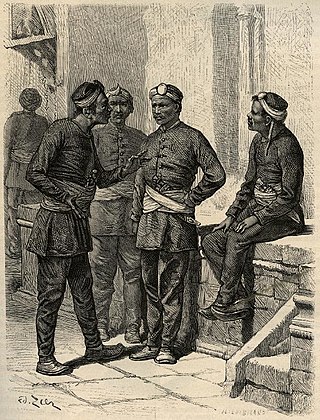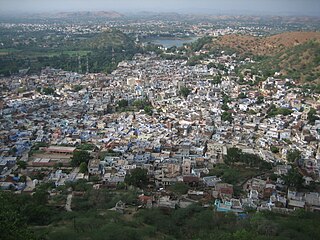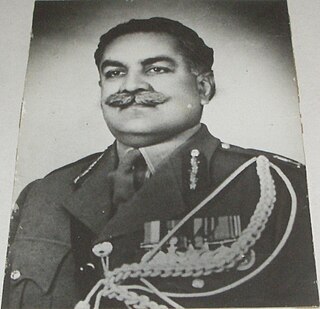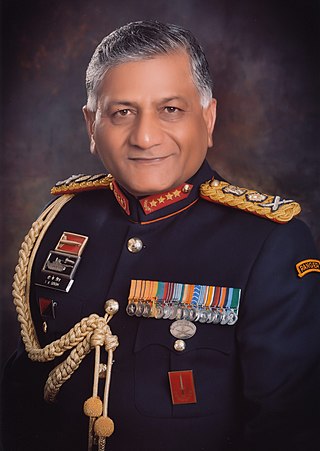
The Gurkhas or Gorkhas, with the endonym Gorkhali, are soldiers native to the Indian subcontinent, chiefly residing within Nepal and some parts of North India.

Colonel Rajyavardhan Singh Rathore,, is an Indian politician, Olympic medallist in shooting and retired colonel in the Indian Army. He is serving as a cabinet minister at the Industry & Commerce, Youth Affairs & Sports Department in the Government of Rajasthan since December 2023. Rathore was a Member of Parliament in the Lok Sabha from Jaipur Rural seat since 2014 till 2023.

Mayo College is a boys-only private boarding school in Ajmer, Rajasthan, India. It was founded in 1875 by the 6th Earl of Mayo, who was the Viceroy of India from 1869 to 1872, making it one of the oldest public boarding schools in India.

The Chief of Army Staff (COAS) is the office of the titular-cum-professional head of the Indian Army (IA), the land forces branch of the Indian Armed Forces. Customarily held by a four-star general officer, the COAS is the senior-most operational officer of the IA, tasked with the roles of overseeing the overall functioning of the force during peace and wartime, committing to the preparation-cum-maintenance of the force's operational effectiveness and defending the nation's territorial integrity-cum-sovereignty. Also a permanent member of the Chiefs of Staff Committee (COSC) and the National Security Council (NSC), the COAS also bears the responsibility of advising the nation's civilian leadership i.e., the Central Government on all matters privy to the IA.
A King commissioned Indian officer (KCIO) was an Indian officer of the British Indian Army who held a full King's commission after training in the United Kingdom, either at the Royal Military College, Sandhurst for infantry officers, Woolwich for artillery officers, and Chatham and Woolwich for engineer officers. They had full command over British and Indian troops and officers. In contrast, the Indian commissioned officers (ICOs), who were trained at the Indian Military Academy at Dehra Dun, and the Viceroy's commissioned officers (VCOs), only had authority over Indian troops and officers. KCIOs were introduced in the early 20th century under the Indianisation process. They were equivalent in every way to the British officers holding a King's commission. In essence, they were commissioned by the King himself at a special induction ceremony. They held the same ranks and privileges as British officers. In fact, most KCIOs served on attachment to a British unit for a year or two early in their careers.
Field marshal is a five–star officer rank and the highest attainable rank in the Indian Army. Field marshal ranks immediately above general, but is not in use in the army's current structure. Awarded only twice, field marshal is a rank bestowed on generals for ceremonial purposes or during times of war.

Dungarpur is a city in the southernmost part of Rajasthan, India.

Field Marshal Kodandera Madappa Cariappa, was an Indian military officer and diplomat who was the Indian Commander-in-Chief (C-in-C) of the Indian Army. He led Indian forces on the Western Front during the Indo-Pakistani War of 1947. He was appointed Commander-in-Chief of the Indian Army in 1949. He is one of only two Indian Army officers to hold the five-star rank of Field Marshal; the other being Field Marshal Sam Manekshaw.

General Kodendera Subayya Thimayya was the 3rd Chief of Army Staff from 1957 to 1961 during the crucial years leading up to the conflict with China in 1962. Thimayya was the only Indian to command an Infantry brigade in battle during the Second World War and is regarded as the most distinguished combat officer the Indian Army has produced. After the Korean War, Thimayya headed a United Nations unit dealing with the repatriation of prisoners of war. After his retirement from the Army, he was appointed Commander of the United Nations Peace Keeping Force in Cyprus from July 1964 to December 1965 and died in Cyprus while on active duty on 18 December 1965.

Lieutenant General Sagat Singh, PVSM was a General Officer in the Indian Army, notable for his participation in liberation of Goa and later in Indo-Pakistani war of 1971. He held many commands and staff appointments throughout his career.

The Kingdom of Mewar, sometimes known as Udaipur State, was an independent kingdom in Rajputana region of India, ruled by the Sisodia dynasty. It was established around the 6th century by the minor rulers of the Nagada-Ahar region of Udaipur and later, in the 10th century, it transformed into an independent state under Rawal Bharttripatta II.

Lieutenant-General Kanwar Bahadur Singh, MBE, was a senior officer in The Kumaon Regiment of Indian Army.

General Pran Nath Thapar was the fourth Chief of Army Staff of the Indian Army. The Sino-Indian War was fought during his term, in which the Indian Army fared poorly. Thapar resigned during the last stages of the war, handing charge to Lt. Gen. J. N. Chaudhuri.

General Vijay Kumar Singh(retd), PVSM, AVSM, YSM, ADC is an Indian politician and a former four-star General in the Indian Army. He is the current Minister of State in the Ministry of Road Transport and Highways and Ministry of Civil Aviation in the Second Modi ministry. He previously served as Minister of State for External Affairs, Minister of State for Development of the North-Eastern Region and Minister of State for Statistics and Programme Implementation in the First Modi ministry.

General Bikram Singh, PVSM, UYSM, AVSM, SM, VSM, ADC is a retired Indian army officer who served as the 24th Chief of Army Staff (COAS) of the Indian Army. Previously the General Officer Commanding-in-Chief of the army's Eastern Command, he succeeded General V. K. Singh as COAS on May 31, 2012. He retired on 31 July 2014. He is the second Sikh to be COAS, the first having been General J. J. Singh. He was also the Chairman of the Chiefs of Staff Committee (CoSC) of the Indian armed forces.

Maharana Raj Singh I, was the Maharana of Mewar Kingdom and eldest son of Maharana Jagat Singh I. He fought against Mughal Empire and annexed many Mughal territories He participated in Rajput-Mughal War (1679–1707) and defeated the Mughals.
Thakur Mahadeo Singh DSO was an Indian Army general who was the first Indian Commandant of the Indian Military Academy and the first Commandant of the Joint Services Wing, the precursor to the National Defence Academy.













